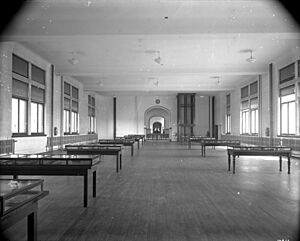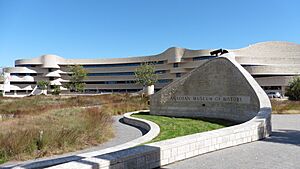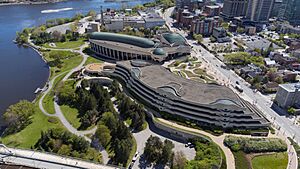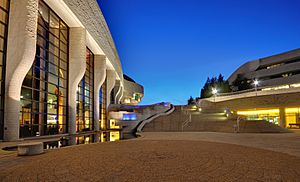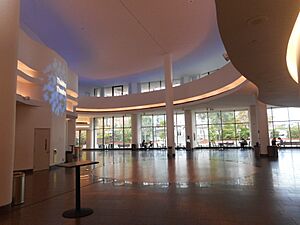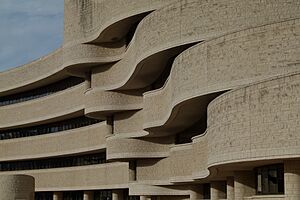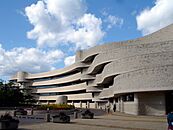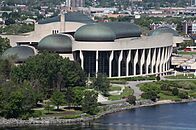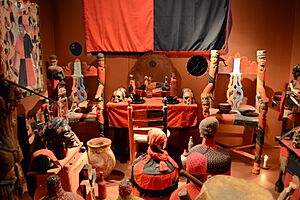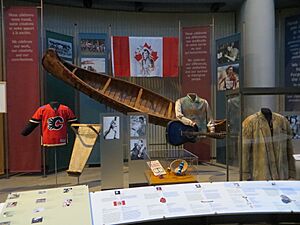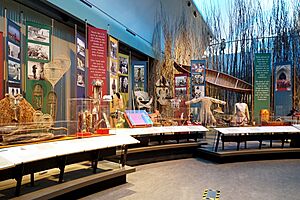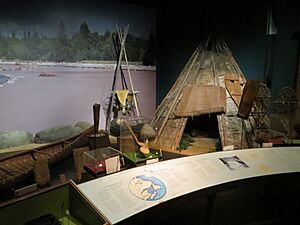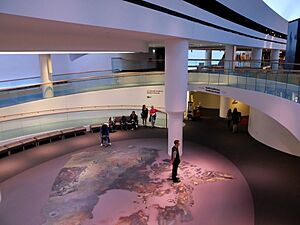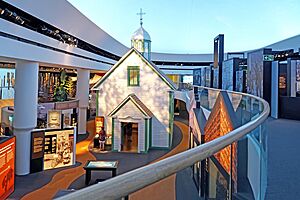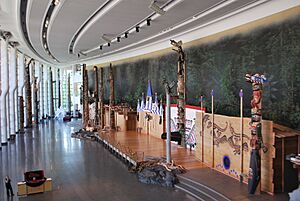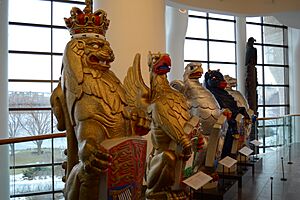Canadian Museum of History facts for kids
| Musée canadien de l'histoire | |
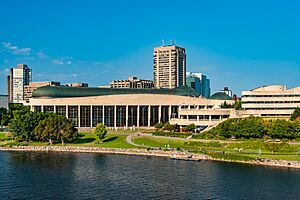
The museum from across the Ottawa River
|
|
| Established | 1856 |
|---|---|
| Location | 100 Laurier Street, Gatineau, Quebec, Canada |
| Type | Anthropology, cultural, ethnology, and history museum |
| Architect | Douglas Cardinal |
| Owner | Canadian Museum of History |
| Canadian Museum of History Corporation network | |
|
|
The Canadian Museum of History (French: Musée canadien de l’histoire) is a big national museum in Gatineau, Quebec, Canada. It teaches us about Canadian history, different cultures, and the story of people. The museum's main goal is to share Canada's amazing past and support research about it. The building itself is huge, covering about 75,000 square meters, and was designed by a famous architect named Douglas Cardinal.
The museum started way back in 1856 as part of the Geological Survey of Canada. It grew over time and added a section for studying people and cultures in 1910. In 1927, it became the National Museum of Canada. Later, in 1968, it split into different museums, and the part focused on human history became the National Museum of Man. The museum moved to its current home in Gatineau in 1989. The next year, it changed its name to the Canadian Museum of Civilization. In 2013, it got its current name, the Canadian Museum of History. Its purpose also changed to focus more on what makes up Canadian identity and history.
The museum has over three million items and documents in its collection. Some of these are shown in the museum's main exhibits. The museum also has many special exhibits that change, travel to other places, or can be seen online. One example is the Virtual Museum of New France.
Contents
History of the Museum
How It Started (1856–1968)
The Canadian Museum of History began with the Geological Survey of Canada (GSC). This group was formed in 1842 in Montreal. In 1856, a law was passed that allowed the GSC to open a museum. This museum would show items found during their trips to study geology and old artifacts. The first museum was in Montreal.
From 1862 to 1863, the museum had its first exhibit about different cultures. It showed stone tools and pottery pieces made by First Nations people. In 1877, the museum's job officially grew. It now included studying animals, plants, human history, languages, and traditions.
In 1881, the museum moved to downtown Ottawa. The new building, called the Former Geological Survey of Canada Building, soon became too small. By 1896, people were asking the government to build a bigger museum. Plans for a new building started in 1899, and construction began in 1906. The next year, the museum's management moved to the Department of Mines. Its purpose officially expanded to include studying people and cultures. The new museum building, the Victoria Memorial Museum Building, was finished in 1910 and opened to the public in 1911.
In 1910, the museum created an anthropology division. This division was led by Edward Sapir. Another expert, Marius Barbeau, joined in 1911 to help Sapir. Their job was to protect the cultural heritage of people in Canada. They also collected objects related to these cultures. At first, their research focused on Aboriginal communities. They believed these communities were changing quickly. The museum's first exhibits on people and cultures were put together by Sapir and Franz Boas. Since then, the museum has been a key place for studying Canadian anthropology. Many famous anthropologists, like Diamond Jenness, worked there after the Second World War.
In 1927, the museum part of the Department of Mines was renamed the National Museum of Canada. In 1950, its management moved to the Department of Resources and Development. In 1965, the museum split into two parts. One focused on natural history, and the other on human history. The museum's role continued to grow. In 1958, it started managing the Canadian War Museum. In 1964, its human history part created a history division.
Museum of People and History (1968–Present)
On April 1, 1968, the National Museum of Canada officially split into separate museums. The Canadian Museum of History came from the human history part. It was first called the National Museum of Man. The natural history part became the National Museum of Natural Sciences. This museum was later renamed the Canadian Museum of Nature. The science and technology part became the National Museum of Science and Technology. It was later renamed the Canada Science and Technology Museum. The government created the National Museums of Canada Corporation to manage these museums. This also included the National Gallery of Canada. Even though they split, the National Museum of Man and the National Museum of Natural History still shared the Victoria Memorial building. The National Museum of Man used the western half.
In April 1972, the National Museum of Man created a Communications Division. This division shared information about the museum's education programs. In the 1970s, the museum's staff wanted to make its collection more open to the public. The Victoria Memorial Museum building was too small for the growing collection. So, the museum's items and staff were spread across 17 different buildings.
In 1980, the management of the National Museums of Canada Corporation moved to the Department of Communications. In June 1981, the government approved plans to move the National Museum of Man to a new building. This plan was announced to the public in February 1982. Several locations were considered in Ottawa and Gatineau. A site in Gatineau was chosen. It was already public land, connected to Confederation Boulevard, and had a great view of the Ottawa River. This site was also chosen because officials wanted to develop the area into an urban park. On February 10, 1983, the new museum site was announced. Douglas Cardinal Architect Limited was chosen to design the building. His design was approved in 1983.
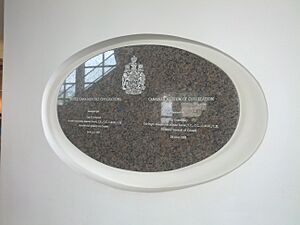
To avoid old-fashioned language, the museum's name changed to the Canadian Museum of Civilization in 1986. In 1988, the museum took over the museum run by Canada Post. However, its philatelic (stamp) collection moved to the National Archives of Canada. The museum opened its new building in Gatineau in 1989. But it only had two main exhibits ready: Canada Hall and the exhibits on the Indigenous peoples of the Pacific Northwest Coast. This was because of money problems.
In 1990, the Museum Act was passed by the government. This law created new groups to manage Canada's national museums. The Canadian Museum of Civilization corporation was formed on July 1, 1990. It managed both the Canadian Museum of Civilization and the Canadian War Museum.
21st Century Changes
In 2007, the museum had a special exhibit called Treasures from China. This was done with the National Museum of China. As part of this agreement, Canadian Indigenous artifacts were shown in Beijing. This exhibit was called First Peoples of Canada: Masterworks from the Canadian Museum of Civilization.
In October 2012, James Moore, the Minister of Canadian Heritage, announced $25 million to update the museum. This included renovating Canada Hall. The government planned to reopen the updated gallery in 2017. This was to celebrate Canada's 150th anniversary of Canada. About 24,000 people from nine Canadian cities were asked for their ideas about the updates. The museum also talked with groups focused on women's history, Indigenous history, and different time periods.
In December 2013, a new law, the Canadian Museum of History Act, was passed. This law changed the museum's main goal. It now focused on increasing knowledge of Canadian history and identity. It also expanded to include social and political history. The law also changed the museum's name from the Canadian Museum of Civilization to the Canadian Museum of History. The Canadian Postal Museum, which was inside the museum, closed in 2012 because of this change.
There were some discussions about the new focus and the updated Canada Hall. Some people wondered if it would only show certain parts of history. However, the museum said that the new exhibits would cover many different topics. They would also explore the country's "dark episodes." The updated gallery cost about $30 million. It opened on Canada Day in 2017. Charles, Prince of Wales and Mélanie Joly, the Minister of Canadian Heritage, were there. People were happy with the new Canadian History Hall when it was revealed.
In 2025, a hobbyist built a Lego model of the museum. The architect, Douglas Cardinal, even sent him 80 pages of building plans for the project!
Museum Location and Building
Where the Museum Is Located
The museum sits on a large piece of land, about 9.6 hectares (23.7 acres). This area used to be called Parc Laurier. It is the first Canadian national museum to be on the Gatineau side of the capital region. It is also the first one right next to the Ottawa River.
The museum property is bordered by the Alexandra Bridge to the west, the Ottawa River to the east, and Laurier Street to the west. The land slopes down towards the Ottawa River. Because of this slope, the museum building had to be built closer to Laurier Street.
The museum building has two main parts, or wings. These two wings curve around a large, round entrance area. This area has food services, a lounge, a library, and underground parking. The open space between the two wings is meant to look like the "plains over which mankind migrated" over thousands of years. A big staircase goes down from the entrance area to a lower plaza and gardens by the river.
There is also a path for walking and biking along the riverfront. This path continues north into Jacques-Cartier Park, which is a city park.
The Museum Building Design
The museum building is 75,000 square meters in size. It was designed by Douglas Cardinal. The building uses about 56,000 square meters of concrete and 7,300 tonnes of steel. Cardinal wanted to create a "sculptural icon" for Canada. The prime minister at the time, Pierre Trudeau, encouraged him to design something that showed Canada's cultures. Because of this, the building was the first in the capital region to include designs inspired by Indigenous architecture. Cardinal's design was greatly influenced by how he understood Canada's geography.
The museum building has over 25,000 square meters of exhibit space. This is more than any other museum in Canada. Besides exhibits, the building also has three restaurants, a gift shop, and two theatres for live shows. One theatre has 500 seats. There is also a 295-seat 3D theatre. Before 2016, this was an IMAX theatre.
Water from the Ottawa River is used to heat and cool the building. The building gets its energy from two power stations in Gatineau. There are also two backup generators in case those fail.
Outside the Building
The outside of the building is covered with 30,000 square meters of Tyndall stone. This stone was chosen because it is strong and connected to glaciers.
Cardinal wanted the building to look like it was "flowing with the contours of the land." He used simple lines and shapes to show movement. The building's design uses Art Nouveau styles. It shows Canada's landscape at the end of the Last Glacial Period, when the land was mostly flat. Some parts of the building look like igloos, earth lodges, and longhouses.
The building has a northern wing that sticks out, which is for museum staff. The southern wing holds most of the public areas, like galleries and theatres. The staff wing was designed to look like rock formations from the Canadian Shield. The southern public wing, with its glass-fronted Grand Hall, was meant to look like a melting glacier. The copper roof of the southern wing represents plants growing back on land once covered by ice. This copper roof is almost 11,000 square meters and weighs about 90 tonnes. Both wings are curvy on the river side to blend with the landscape. However, their street side is more angular.
There were rules for the building's design. It could not block the view of the Ottawa River. It also could not block specific "viewing cones" of Parliament Hill from Gatineau. Because of these rules, the buildings were designed to be low. This way, they would not block the view for buildings across the street. From some angles, the building looks like two separate parts. An opening between them gives a clear view of Parliament Hill from Laurier Street. Care was also taken to protect the artifacts inside. Windows have three layers of glass and a special film. This helps control heat and reduce harmful sunlight. The Grand Hall was designed so that direct sunlight only hits it in the morning.
The building was designed to create "ever-changing patterns" of shadows. Most of the outside lights are kept dim. This allows for deeper shadows at night.
Museum Exhibitions
The museum has many permanent and temporary exhibits. These exhibits cover topics like anthropology (the study of people), ethnology (the study of cultures), and history. Items from the museum's collection are shown in these exhibits. Sometimes, special exhibits that travel from other places are also shown. The museum has also created several online exhibitions, like the Virtual Museum of New France.
Permanent exhibits include the First Peoples Hall, Canadian History Hall, the Canadian Children's Museum, and the Canadian Stamp Collection. There are also two exhibits about the Indigenous peoples of the Pacific Northwest Coast in the Grand Hall. The First Peoples Hall is on the first floor. The Canadian History Hall is on the third floor. The First Peoples Hall is next to the Grand Hall, with its exhibits on the ground floor.
Many of the exhibits designed in the 1980s were influenced by the museum's director, George F. MacDonald. He admired the art and culture of the Pacific Northwest Coast. He was also influenced by the ideas of Marshall McLuhan. When planning the museum's move in the 1980s, the design team thought about combining exhibits on Indigenous peoples of Canada with other Canadian history exhibits. However, they decided to show them as separate exhibits at first. This meant different teams and budgets for each. This decision changed in 2017. When the Canadian History Hall reopened, Indigenous exhibits were included throughout.
First Peoples Hall
The First Peoples Hall opened in 2003. It explores the history and cultures of Canada's First Nations, Inuit, and Métis peoples. The exhibit covers about 3,500 square meters on the ground floor. It has more than 2,000 objects on display. Most of the space is for changing exhibits. This helps keep up with new ideas about traditional cultures and current issues. However, some parts of the First Peoples Hall are for long-term exhibits. These exhibits cover topics that do not change as much. Examples include ancient history, Indigenous languages, and the history between Indigenous and European cultures. The exhibit is divided into sections like "Ways of Knowing," "An Ancient Bond with the Land," and "The Arrival of Strangers."
The exhibit was designed to help visitors understand history in new ways. It addresses common ideas about Indigenous identity. It also shows the many different cultures among Indigenous nations. Many exhibits connect identity to Indigenous land claims in Canada. The exhibits also show Indigenous peoples as living people in today's world. Archaeological exhibits in the First Peoples Hall show that Indigenous peoples have lived on the land since time immemorial. They also show that Canadian history is long and complex, even before Europeans arrived. Many of these exhibits also challenge the idea that Europeans had better technology when they first met people in the Americas. The exhibit ends with current issues. It explores recent disagreements between Indigenous and non-Indigenous peoples in Canada over land and resources.
The way the exhibit was put together followed ideas from a 1992 report. This report was from the Task Force on Museums and First Peoples. The content and messages of the First Peoples Hall were decided with help from Indigenous communities across Canada. An advisory committee of 15 Indigenous members was formed. They helped decide the main themes and messages of the exhibit. Because of this, the exhibits in First Peoples Hall show many different viewpoints. Different ideas, like archaeology, ethnology, and traditional Indigenous knowledge, are shown side-by-side. Sometimes, they even offer different explanations.
Canadian History Hall
The Canadian History Hall is an exhibit that explores Canadian history. It is about 5,050 square meters in size. It uses over 14 projectors and 58 screens. The exhibit has three main galleries and a long, curved walkway that leads to them. The walkway has 101 silhouettes of Canadian symbols and activities. The galleries are built around a central area designed by Douglas Cardinal. It looks like Chaudière Falls. This central area has a huge 15.5 by 9.5 meter image of Canada on the floor. This image is made from 121 satellite photos taken by the Canadian Space Agency.
The exhibit covers over 15,000 years of history. It is divided into three galleries based on time periods. These are Early Canada: From Earliest Times to 1763, Colonial Canada: 1763 to 1914, and Modern Canada: 1914 to the Present Day. The first two galleries are on the same floor. The third gallery is on a mezzanine above them. The galleries show important events and "turning points" from each time period. They use multimedia presentations and artifacts. Each gallery is also divided into six smaller "vignettes." These are different themes but are connected. They are mostly organized by time, but some focus on a specific part of Canadian history. The exhibit teaches about the country's political and economic history. It also focuses on the experiences of Indigenous peoples. According to David A. Morrison, the head of the exhibit team, Indigenous peoples and their relationship with newcomers are a very important theme in the Canadian History Hall.
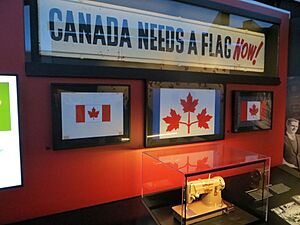
Early Canada talks about Indigenous history before Europeans arrived. It also covers early Canadian colonies like New France. This gallery has Indigenous artifacts. It tells stories of how Indigenous peoples interacted with Norse, English, and French explorers. It also gives details about the North American fur trade, the spread of diseases among Indigenous populations, and the Beaver Wars. Colonial Canada explores Canada under British rule after the conquest of New France. It also covers post-Confederation Canada up to 1914. Modern Canada explores Canada's recent history, up to the arrival of Syrian refugees in the 2010s. The last two galleries give detailed histories of the Seven Years' War, treaties signed between Indigenous groups and the Crown, the push for responsible government, Canadian Confederation, the world wars, the Canadian Indian residential school system, Quebec nationalism, and multiculturalism in Canada.
There are over 1,500 artifacts in the Canadian History Hall. These include an ivory carving from 3,600 to 3,900 years ago. It is believed to be the oldest image of a human face found in Canada. Other items include James Wolfe's coat, handcuffs worn by Louis Riel, Maurice Richard's hockey jersey, Terry Fox's T-shirt, and Tommy Douglas's hat. Also on display is the table where Queen Elizabeth II signed the Constitution Act, 1982 in 1982. You can also see Randy Bachman's guitar and the sewing machine Joan O'Malley used to sew the first Maple Leaf flag. There are 40 short films shown in the exhibit. One film, Origin Stories, shows how the Anishinaabe people believe the earth was formed. This film is shown along the curved wall at the entrance of the Canadian History Hall.
The way the exhibits are built allows the museum to easily change parts. The number of exhibits in the galleries might also grow. The museum has saved space for new exhibits in the three galleries.
Before 2017 Exhibition
Before the Canadian History Hall, there was Canada Hall. It opened in 1989 as one of the museum's first exhibits. The original exhibit had 23 sections arranged by time, starting with the Norse colonization of North America. It aimed to show Canada's many cultures. It told a story of immigrants moving from east to west and different groups succeeding in Canada. However, these sections did not go deep into pre-colonial Indigenous cultures. These were only explored in other museum exhibits before Canada Hall was updated in the 2010s. The original Canada Hall recreated historical scenes with rooms and full-sized historical buildings. This reflected McLuhan's ideas and new ways of showing things, like at Disney's Epcot.
Canada Hall closed in September 2014 for renovations and major updates. The exhibit reopened in 2017, looking very different. Almost all of the life-sized scenes were taken apart. St. Onuphrius Church, an actual early-20th-century Ukrainian church from the Canadian Prairies that was moved to the museum, is the only remaining life-sized scene in the exhibit.
Canadian Children's Museum

The Canadian Children's Museum is Canada's largest exhibit area made just for kids. It has over 3,000 square meters of space. The museum uses more than 15,000 items for its exhibits and programs. These include art, clothes, games, photos, and toys. The museum has an International Village and Canadian-themed attractions. These Canadian attractions were added in 2007.
In 2018, the museum announced it would start a renewal project in January 2020. The museum said the changes would show how children play and learn. It would also remove older exhibits, like the post office and telephone booth. It reopened in May 2022.
Canadian Stamp Collection
The Canadian Stamp Collection has more than 3,000 stamps. It includes every Canadian stamp made since 1851. This stamp collection was at the Canadian Postal Museum until 2012. When the postal museum closed, the stamp collection moved to the Canadian Museum of History. The Canadian Museum of History opened a permanent exhibit for the collection in 2014. This was done with Canada Post. The stamps in the exhibit are shown with items that either inspired them or were used to make them.
Grand Hall Exhibitions
The Grand Hall has two permanent exhibits about the Indigenous peoples of the Pacific Northwest Coast. These are First Peoples of the Northwest Coast and From Time Immemorial — Tsimshian Prehistory. The exhibits include totem poles and other artifacts. These exhibits were created by the museum's experts and Indigenous cultural specialists in the 1980s.
In 1993, a large painting called Morning Star was added to the domed ceiling of the Grand Hall. This painting was created by Alex Janvier. It represents Indigenous life and history. Besides the two permanent exhibits, the Grand Hall is also used for other big events. It has also hosted temporary exhibits.
Museum Collections
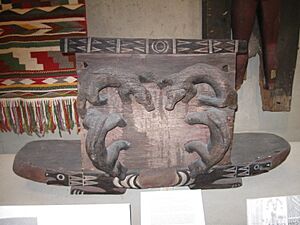
As of June 2021, the Canadian Museum of History's collection has over three million items. These include artifacts, documents, artworks, and other specimens. This includes more than one million photos, 72,000 sound recordings, and 18,000 films and videos. The collection takes up about 4 kilometers (2.5 miles) of shelf space. About 218,000 artifacts have been put online by the museum.
The museum's collection dates back to the items gathered by the Geological Survey of Canada in the 1860s. The collection has grown through the museum's research programs. The first collection of Indigenous items was started by the Geological Survey of Canada. Other parts of the collection were bought by government officials and missionaries. The collection kept growing after the anthropology department started in 1910. The museum then began to systematically record Indigenous cultures and family histories.
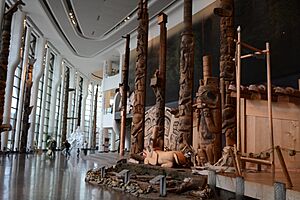
The museum's collection of Indigenous items is the largest in Canada. It is the only major collection that covers the whole country. The museum also has the world's largest collection of totem poles. The Sacred Materials Project was created by the museum. It helps care for Indigenous sacred items. It also helps return certain items to their communities. The project provides money for Indigenous representatives to see the museum's collections. They can discuss returning sacred items. They can also identify other objects that need special care.
The museum's collection has several smaller collections. One is the Windfield Farm Collection. The museum got this collection in 2013. It has documents, photos, souvenirs, and trophies. This includes the Kentucky Derby trophy won by Northern Dancer. The museum's flag collection is also the largest in the country.
Other important items in the museum's collection include a Contempra phone. This was the first telephone designed and made in Canada. There is also cough syrup from the 1918 influenza pandemic. You can see the original plaster model for Bill Reid's Spirit of Haida Gwaii. There are ten large sculptures called The Queen's Beasts. Also, a royal gown worn by Queen Elizabeth II during her visits to Canada. The museum also has many ice hockey items. These include National Hockey League sticks used in games, hockey cards, and the world's oldest existing ice hockey stick. This hockey stick is from the mid-1830s. The museum bought it in 2015 for $300,000.
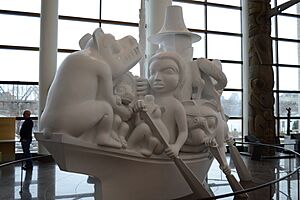
Besides its own collection, the Canadian Museum of History also works with other groups to manage collections. In July 1999, the museum made an agreement with the Canadian Nursing Association (CNA), the Canadian War Museum, and the National Archives of Canada. They created the Canadian Nursing History Collection. This collection has over 9,000 photos, 1,600 videos and audio recordings, and over 35 meters (115 feet) of written records. About 950 documented items from this collection are kept at the Canadian Museum of History. Items from the collection at the museum include 167 nurses' caps, from 1895 to 1983. In June 2005, the museum opened a temporary exhibit about this collection. In 2021, the Canadian Museum of History agreed to keep and care for items from Canada's Sports Hall of Fame.
Library and Archives
The museum has a resource center with a library and archives. As of 2015, the museum's library has more than 60,000 books. It also has over 2,000 journals and magazines. There are more than 1,000 DVDs, CDs, and video tapes. The museum's collection of rare and old books includes Paul-Émile Borduas's Refus Global (1948). It also has Pierre François Xavier de Charlevoix's Histoire et description générale de la Nouvelle-France (1744).
Museum Research
The museum's collection is used to help with research. This research covers topics like anthropology, archaeology, Indigenous people in Canada, languages, and social and political history. The museum also publishes its own academic journal, the Mercury Series. This journal covers history, archaeology, and anthropology. It has been published with the University of Ottawa Press since 2012. The museum has also published the academic journal Material Culture Review since the 1970s. This journal provides a place for research on historical items collected by Canadian museums.
How the Museum is Managed
| Musée canadien de l’histoire | |
| Corporation overview | |
|---|---|
| Formed | June 1, 1990 |
| Preceding Corporation |
|
| Headquarters | Gatineau, Quebec |
| Minister responsible |
|
| Parent department | Canadian Heritage |
| Key documents |
|
The Canadian Museum of History is run by a federal Crown corporation with the same name. It is part of the Department of Canadian Heritage. This corporation manages two national museums: the Canadian Museum of History and the Canadian War Museum. It also runs the Virtual Museum of New France. This is an online exhibit of the Canadian Museum of History. The corporation also manages the Virtual Museum of Canada. This program helps other museums create online projects. The Virtual Museum of Canada used to be an online portal for virtual exhibits until 2020. Now, it focuses on supporting other projects.
The corporation is managed by an 11-member board of trustees. These trustees are chosen by the Minister of Canadian Heritage. The board then chooses the corporation's president and chief executive officer. The corporation reports to the Parliament of Canada through the Minister of Canadian Heritage. The corporation's job is set out in the Museums Act.
The corporation was created as the Canadian Museum of Civilization in June 1990. This happened through the Museums Act. This law was later changed in 2014. The corporation got its current name in 2013. This Crown corporation was one of several that took over from the National Museums of Canada Corporation. That corporation managed most of the country's national museums until it closed in 1988.
See also
 In Spanish: Museo Canadiense de la Historia para niños
In Spanish: Museo Canadiense de la Historia para niños
- List of museums in Ottawa
- List of museums with major collections in ethnography and anthropology
- National museums of Canada


